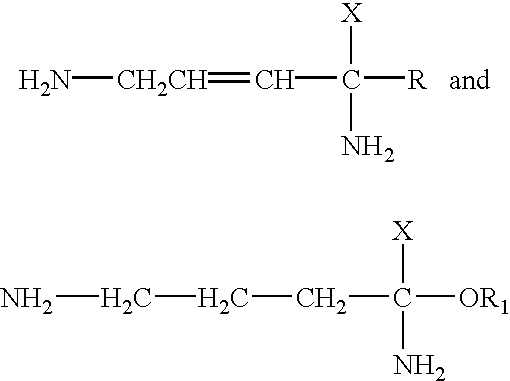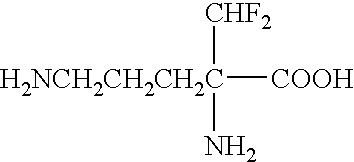Use of polyamine analogs for amyotrophic lateral sclerosis
a polyamine analog and amyotrophic lateral sclerosis technology, applied in the field of modulating the activity of the polyamine pathway, can solve the problems of invariably fatal outcome, low lipophilic activity, and inability to completely eliminate the damage caused by the disease, so as to improve the solubility of the pharmacological agent, improve the effect of lipophilic compound administration and high lipophilic activity
- Summary
- Abstract
- Description
- Claims
- Application Information
AI Technical Summary
Benefits of technology
Problems solved by technology
Method used
Image
Examples
example 1
Methods and Materials
[0170] (i) Model Description: The SOD1 G93A (high copy) mouse model was used as the model for ALS. This mouse model carries 25 copies of the human G93A SOD mutation and is driven by the endogenous promoter. Survival in the mouse is copy dependent. The high copy G93A has a median survival of around 128 days. High molecular weight complexes of mutant SOD protein are seen in the spinal cord beginning around day 30. At day 60 reactive astrocytosis (GFAP reactive) are observed; activated microglia are observed from day 90 onwards. Studies by Gurney et al. showed that at day 90 reactive astrocytosis loses statistical significance while microglial activation is significantly elevated and continues to be elevated through the end stage of the disease.
[0171] Many drugs that have shown efficacy in this model have move forward into human clinical trials based on the data resulting form studies with this model. Experience with riluzole, the only approved drug in the treatmen...
example 2
Treatment of ALS in a SOD-1 (G93A) Mouse Model With Discontinuous Dosing of DFMO
[0187] During this study, DFMO was delivered chronically at a dose of 3200 mg / Kg / day in drinking water for 21 days followed by a 7 day drug holiday (no drug) according to the methods described in Example 1. Results are shown in FIGS. 2 and 3 and described below.
[0188] Percent Survival Analysis: In the females 70% of the deaths of animals in the treatment group occurred during the time of drug holiday or a few days immediately succeeding the holiday. However, only 30% of deaths occurred in the control group during the same period (FIG. 2). DFMO, a substrate analog inhibitor of ornithine decarboxylase delays the onset of disease and extends the survival of the SOD1 G93A mouse.
[0189] Neurological Score analysis: No effect was seen in the combined results or in the male mice (data not shown). However, discontinuous delivery of DFMO was protective in the female SOD1 G93A mouse during the course of drug delive...
example 3
Treatment of ALS in a SOD-1 (G93A) Mouse Model With Continuous Dosing of DFMO
[0190] During this study, DFMO was delivered chronically at a dose of 3200 mg / Kg / day in drinking water for 21 days without any drug holiday until death according to the methods described in Example 1. Results are shown in FIGS. 4-9 and described below.
[0191] Percent Survival Analysis: DFMO extended the life span of the SOD1 G93A mice as shown in FIGS. 4, 6 and 8. DFMO, a substrate analog inhibitor of ornithine decarboxylase delays the onset of disease and extends the survival of the SOD1 G93A mouse.
[0192] Neurological Score analysis: Continuous delivery of DFMO was protective in the combined results of the male and female SOD1 G93A (FIG. 5) as well as in the male (FIG. 7) and female (FIG. 9) SOD1 G93A population. The total combined effect was 9.69% (p=0.02) when analyzed by Cox proportional hazard using litter effect as a frailty term. The male mice showed an 8.21% effect while the female mice showed an 11....
PUM
| Property | Measurement | Unit |
|---|---|---|
| survival time | aaaaa | aaaaa |
| concentrations | aaaaa | aaaaa |
| half life | aaaaa | aaaaa |
Abstract
Description
Claims
Application Information
 Login to View More
Login to View More - R&D
- Intellectual Property
- Life Sciences
- Materials
- Tech Scout
- Unparalleled Data Quality
- Higher Quality Content
- 60% Fewer Hallucinations
Browse by: Latest US Patents, China's latest patents, Technical Efficacy Thesaurus, Application Domain, Technology Topic, Popular Technical Reports.
© 2025 PatSnap. All rights reserved.Legal|Privacy policy|Modern Slavery Act Transparency Statement|Sitemap|About US| Contact US: help@patsnap.com



